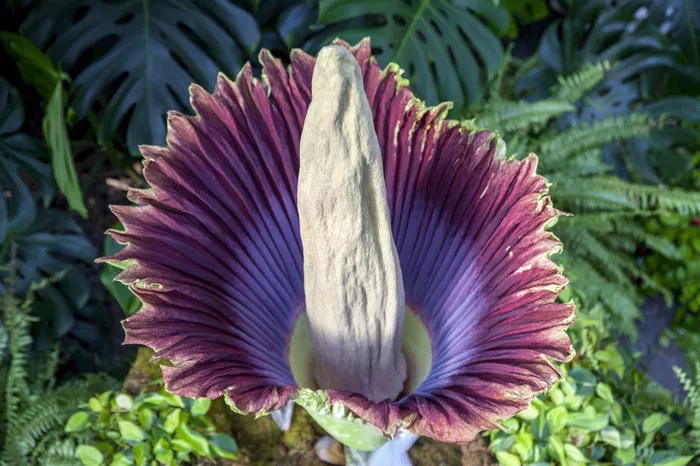A rare occurrence has taken root in Dexter, Michigan, as a towering corpse flower unfurls its petals, setting a new record in the state’s botanical history. Aptly dubbed “Corpsy” by its caretakers, this peculiar plant, known for its distinctive aroma akin to decaying flesh, stands tall at an impressive height of 63.5 inches. This remarkable bloom marks not only a milestone in the state’s floral landscape but also a first-ever occurrence of a corpse flower blossoming within the confines of a private residence.
Originating from the lush landscapes of Sumatra, where it thrives in conservatories across the globe, the corpse flower, scientifically known as Amorphophallus titanum, is renowned for its rare and fleeting bloom. Lasting a mere 24 to 48 hours, this olfactory spectacle draws both awe and curiosity from enthusiasts and onlookers alike.
For Kevin Hauser, the owner of this botanical wonder, the long-awaited moment evokes a complex array of emotions. Reflecting on the seven-year journey from a modest 2-inch corm acquired in North Carolina to the towering spectacle before him, Hauser muses on the transient nature of this botanical marvel.
“It’s kind of bittersweet because just thinking about her as an organism, and she spent seven years of her life for this 24-hour moment,” he shared.
Accompanied by his wife, Barbie, Hauser welcomed over 100 guests, including family, friends, and members of the community, to witness the fleeting splendor of Corpse Flower’s bloom. Among the visitors, Shelly Vrsek expressed her awe at the rarity of the plant and the meticulous care bestowed upon it by its guardians.
“We read that there’s only 1,000 of them still around, so to have one locally around to see it is really spectacular that they are taking all this care and they have babies, which is exciting to see, too,” Vrsek remarked.
Despite its captivating allure, the corpse flower’s fragrance, likened to that of a “rotten refrigerator” or “rotting lettuce” by onlookers, proved overpowering, necessitating precautionary measures to contain its aroma. As Hauser recounted, the stench permeated the air, attracting an unexpected audience of turkey vultures and swarms of flies to the vicinity.
As the bloom reached its crescendo overnight, Hauser marveled at the stunning spectacle unfolding within his conservatory. Although the fleeting nature of Corpse Flower’s bloom is undeniable, Hauser remains committed to nurturing a collection of these rare botanical treasures, each embodying its own unique charm.
As he reflects on his role as a steward of these remarkable plants, Hauser remains steadfast in his conviction that the time and care invested in their cultivation are unequivocally worthwhile.


